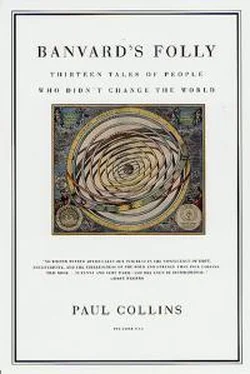Decades passed, and memories of the strange actor faded into oblivion. But one day in 1843, a member of a London gentlemen's club happened to be looking out the window when he spied a strikingly odd figure making his way up St.
James's Street. It was an elderly man, dressed in Hessian boots and clothes
that were thirty years out of date.
Then it dawned upon the watcher.
"It's Romeo Coates!" he shouted.
Club members rushed to the windows. The old man had continued walking past the club, but the distant memory of the shouted phrase arrested his step. He turned around and returned to the club's window, where he politely doffed his hat.
"My name, gentlemen, is Robert Coates."
He then walked onward with perfect elderly gravity, and disappeared into the crowd.
Coates and his wife had moved back after decades away, and taken up lodgings at 13 Portman Street. Coates could be seen in his haunts once again now, though an observer of this seventy-one-year-old man could scarcely have thought him capable of the famed histrionics of his youth.
Visiting old friends in the city, he was sometimes goaded into performing, particularly for younger men and women who had not seen him thirty years before. Watching Coates, they were mystified: why had he been so reviled by critics? During the long decades of Coates's absence, the theater had embraced melodrama; what was once histrionics was now artistic passion. Coates, it seemed, hadn't been born to the wrong style of acting at all. He had simply been born to the wrong era.
Returning to London meant that Coates could indulge in his one great passion again, which was going to the London theaters. And so he died as he lived: by the theater. On the night of February 15, 1848, after attending a show at Covent Garden Theatre, Coates was departing in his carriage when he remembered that he had left his opera glasses on his seat in the theater. He clambered down from the carriage and out onto crowded Russell Street, and into the path of another speeding carriage. He was knocked down; the wheel went over his head.
The carriage sped away, and its driver was never found. A crowd gathered around the bleeding and broken old man. The theater was steps away, just out of his reach.
A. J. PLEASONTON'S BLUE LIGHT SPECIAL
Just off the corner of 19th Avenue and Lincoln is a typical San Francisco house, a white Victorian set back slightly from the avenue. It is easy to miss, wedged as it is between a Chevron station at one end of the block and a Shell station at the other, a house on what is not really a residential block at all; this part of 19th Avenue is, technically, a stretch of US 1, and there is a continual hiss of traffic pouring out of a hole punched into Golden Gate Park.
This house has nothing to distinguish it from innumerable others in the city save for one modification: a front porch that has been glassed in to form a sort of sunroom that one must pass through to enter the house proper. Though there's nothing too strange here--walk around an old college campus back East, like Mount Holyoke's, and you'll find these quaint old sunrooms fading genteelly off at the edge of the old dorms.
But now look up. The top panes of this sunroom are not consistent. They
alternate between clear glass and ancient panes of velvety cobalt blue. It's not much of a design statement, frankly, and yet as the sun slants in through the westward panes in the late afternoon, it does cast the whole sunroom in a rather pretty blue glow.
During the day, when the world is at work, there is little sign of life in the house; it is hard to know anything about its present inhabitants from the outside. But one thing can be known for certain: in the late 1870's, sitting in that sunroom and watching the horse-drawn traffic on the old avenue, someone sat waiting for a cure to what may have been a grave illness. And, perhaps, they waited in that very sunroom until they died.
The second half of the nineteenth century was a miraculous time for medicine; our era merely gilds its lily. Some of the most basic notions of modern medicine were being formed during this time, and mortality rates went into a free fall as a result. Ether eliminated the agonizing pain of surgery. Forceps lowered death rates in childbirth. Hospitals, where cures had often been more fatal than the ailment, changed dramatically: the theory of sepsis meant that doctors and nurses began to clean their hands and their instruments between operations. French medical professors Xavier Bichat and Charles Louis introduced an empirical approach to examining the effectiveness of medical treatments, and a roaring trade in medical cadavers gave a rising new generation of medical students an actual understanding of the functions of internal organs.
But where there is hope, there is also false hope. The triumphant march of medical progress left the public believing that nearly anything was possible, and quacks and charlatans sensed an opportunity. Thanks to the rise of a national parcel post, and the ad pages crammed into the backs of the women's and sporting magazines now distributed across the country, you no longer had to work from town to town as a medicine show, always worrying about getting tarred and feathered and run out on a rail; now you could operate anonymously from the huge new urban centers, placing ads and fleecing suckers with impunity from thousands of miles away.
Useless pills and ointments proliferated, often with thinly veiled promises to desperate consumers. A young woman who had--well--made a mistake could find in the back of women's magazines ads for Chichester's Pennyroyal Pills.
Pennyroyal is an abortifacient, though there is no mention in the ad of that--no mention, in fact, of what these pills were for at all. But every woman knew what pennyroyal meant.
There was just one problem: there was no pennyroyal in the pills.
And so, inevitably, as the pregnancy came to term--assuming the woman hadn't perished in the meantime from a botched illegal abortion--she could buy herself a bottle of Mother's Friend, which, as the Bradfield Regulator Company of Atlanta promised, "shortens the duration of labor" and "will assist in the safe and quick delivery." The actual ingredients of this secret elixir? Oil and a little soap.
Not only did false nostrums thrive, but so did entire fake medical practices, for diploma mills and shoddy medical schools had sprouted up around the country. One of the most notorious and most durable was the American Health College, run for decades from a building in downtown Cincinnati by an old-fashioned quack named John Bunyan Campbell. After years of granting worthless diplomas, the picturesque old rogue was finally hauled before a judge. The prosecutor's cross-examination of Campbell is ludicrously evasive.
("You have no histological laboratory?" "No, not exactly.") Further examination revealed one by one that every member of the school's faculty was
retired or on leave--that, in fact, Campbell was the only faculty member--and that his "vitapathic" treatment largely consisted of applying copper plates to the feet of patients so as to draw the poison out of them.
The cross-examination of Campbell culminated in this masterful display of circular logic about the origins of disease:
Question.--Within the last few years of your practice of vitapathy, what class of cases have you treated?
Answer.--Well, mostly pulling out poisons on our copper plate. We ain't curing disease at all; the person may not have any disease. He is simply full of poison, don't you see?
Question.--What do you consider poisons, doctor?
Answer.--Well, calomel is poison; strychnine is poison; iron is poison.
Question.--Would you consider disease germs poison in the same case?
Answer.--Well, I have a different idea of germs from most everybody else.
Читать дальше











